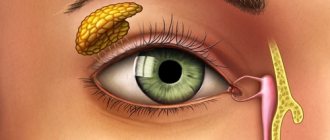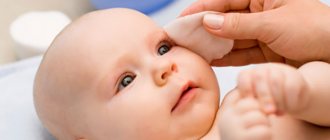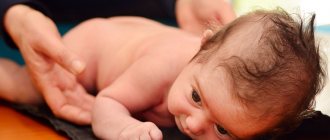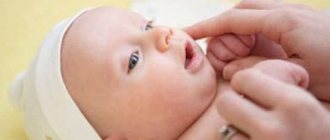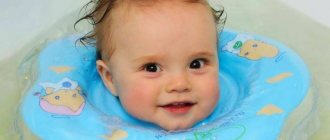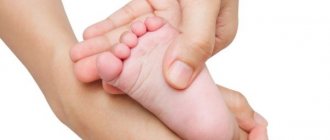Ways to combat the disease
Dacryocystitis can be easily treated for children of any age if they contact an ophthalmologist in a timely manner.
At the initial stage, therapy is carried out using conservative methods in the form of eye drops, physiotherapy and specially designed massage, which we will talk about below. If the disease is advanced and accompanied by complications, surgical intervention cannot be avoided. Often a probing procedure is used to pierce the plug. If this therapy does not bring a positive effect, more serious surgical treatments will be required.
Conservative methods of treating dacryocystitis include gentle remedies in the form of eye drops, preventive massage and physiotherapy. The treatment plan is prescribed by an ophthalmologist, since self-medication can lead to the development of phlegmon of the lacrimal sac, which will inevitably lead to surgical intervention.
Antibacterial eye drops are prescribed to the baby to relieve inflammation and speed up the healing process. They help fight the infection that has arisen. The following medications are prescribed to children:
- Vigamox;
- Gentamicin;
- Levomecitin.
It is important to apply drops to the baby's eyes with clean hands, pre-treated with Chlorhexidine.
The procedure is repeated 2-4 times a day. If the symptoms of the disease are severe, your doctor may prescribe antibiotics for internal administration.
Massage equipment
Properly performed massage of the tear duct can break through the plug. In 30-40% of cases, this technique allows you to save a baby from dacryocystitis without resorting to surgery. The ophthalmologist explains the procedure to the mother, since independence in this matter can provoke complications of the disease.
Initially, you should thoroughly wash and treat your hands with Miramistin or Chlorhexidine solution. The baby's eyes must first be wiped with Furacilin solution, removing excess mucus and pus. Watch the force of pressure on the child's sinuses. Since the baby's bones have not yet fully strengthened, there is a possibility of damage to the cartilage tissue.
The best effect is achieved when the procedure is carried out during or after the newborn’s crying, due to the fact that the natural process promotes the film’s spontaneous rupture.
The massage must be performed using the following technique:
- Place your fingers on the bridge of your nose;
- Lightly pressing on the cavity, gradually palpate from the eye to the beginning of the bridge of the nose in a direction from top to bottom;
- Remove the resulting suppuration with a cotton swab treated with Furacilin solution.
Learn more about the massage technique in the video.
Probing
If conservative treatment methods do not produce a positive effect, the baby is prescribed a probing procedure. The operation is performed under local anesthesia and is indicated for infants aged 2 months and older. The method involves mechanical rupture of the resulting plug using a special tool (probe) resembling a metal wire.
Probing is indicated in the following cases:
- Excessive lacrimation;
- An inflammatory process that develops into a chronic form;
- Lack of positive effect after massage sessions and eye drops;
- Abnormal development of tear ducts.
Upon completion of the procedure, the baby is prescribed rinsing of the nasolacrimal duct for 1-3 months to avoid relapse of the disease. In addition, the ophthalmologist prescribes antibacterial drops, a vitamin complex and immune-supporting drugs.
If the disease is at an advanced stage or there is no positive effect from the above methods of getting rid of dacryocystitis, children are prescribed surgical intervention in the form of intubation of the lacrimal ducts. The surgical method is called dacryocystorhinostomy. The procedure is designed to restore the process of fluid passage through the nasolacrimal duct.
| The formation of an abscess involves surgically opening the abscess and then prescribing antibiotics. |
The surgical intervention is performed under general anesthesia and requires a one-month recovery period. During this time, it is necessary to protect the baby from hypothermia, excessive physical exertion and rubbing the eyes with hands.
Treatment of dacryocystitis in infants and adults
Treatment of dacryocystitis in adults begins from the moment of diagnosis
It is important to properly massage for dacryocystitis in adults for 10-15 days. Additionally, installations of solutions are used: 20% solution of Albucid (sulfacyl sodium), 2% solution of collargol
If the effect is insufficient, then the lacrimal duct and sac are washed under pressure with disinfectant solutions or lacrimal duct antibiotics.
Then the lacrimal ducts are probed with solutions of lidase, fibrinolysin, and trypsin introduced into them. This slows down the process of scarring of the canal. In some cases, rough adhesions must be removed surgically.
Drops for dacryocystitis are prescribed in case of bacterial infection, when pus is released during massage. Antibacterial ointments are not used for dacryocystitis, since they can clog the lacrimal openings due to their dense structure.
Antibacterial eye drops for acute or chronic dacryocystitis in adults:
- Tobrex (tobramycin);
- Tsiprolet, Tsipromed for eyes (ciproflaxacin);
- Floxal ointment for blepharitis, Ofloxacin ointment (ofloxacin);
- Signicef (levofloxacin);
- Levomycetin (chloramphenicol);
- Vitabact (picloxidine);
- Sulfacyl sodium (sulfacetamide);
- Maxitrol (neomycin + polymyxin B + dexamethasone).
Safe rules for lacrimal sac massage in children and adults
It is important to massage the lacrimal sac in newborns with clean hands. This is the only home treatment option for dacryocystitis in a newborn.
The lacrimal sac is located in the inner corner of the eye; you can feel it yourself, then place your finger in the same place for the child and lift it 0.5 cm so that it is fixed above the lacrimal sac.
Using light pressing movements, massage from top to bottom. During one trip, you need to make 10-15 such movements, and then collect the discharge from the lacrimal sac and wipe the area with furatsilin solution. You can supplement the massage for dacryocystitis with movements from the bridge of the nose to the corner of the eye.
Cut your nails before the procedure to avoid damaging your child's skin.
Treatment of dacryocystitis in newborns is carried out within 10 days. If massage does not help with dacryocystitis, you need to move on to the probing stage.
To learn how Komarovsky proposes to treat dacryocystitis in newborns, watch the official video. It shows how a doctor performs a massage for dacryocystitis.
Probing for dacryocystitis
Probing for dacryocystitis in newborns is performed if there are congenital adhesions in the canal, as well as if massage courses are ineffective for 10-15 days.
This is a minimally invasive intervention, which is carried out by introducing a special thin probe into the lacrimal opening and removing it through the nasolacrimal duct to the nasal cavity. If the child is under 1 year old, then probing is performed under local anesthesia. Anesthetics are dripped into the eye, but the children still cry from fear. Children over 1 year of age undergo the procedure under anesthesia or medicated sleep, so it is better not to delay the probing. The procedure itself lasts 10-15 minutes.
The effect of probing for dacryocytitis appears after 3-5 days. The first days after the intervention there may be a slight discharge of pus and traces of tears. For 5 days after the procedure, it is necessary to drip antibacterial drugs into the eye 2 times a day.
If the child has a narrow canal from birth and there are adhesions, then carry out the probing procedure again after 2-3 months. To repeat the procedure, a larger probe is taken and enzymes are introduced into the canal along with it to prevent scarring. There is a high probability that the narrow canal will expand on its own as the child grows. For the period from birth to one year, silicone capillaries can be placed to improve the outflow of tears.
Video of probing for dacryocystitis in newborns.
Causes of the disease
There is no clear answer to the question of the occurrence of pathology, and there are several possible reasons:
- Congenital obstruction of the mucous membrane of the lacrimal canal. This is possible if its composition is abnormally dense.
- Accumulation of bacteria in the tear duct. In this case, even if the film is removed, bacteria begin to enter the lacrimal sac, and clogging occurs precisely with bacteria and their metabolic products.
- Anomalies in the formation of the nasal bone during fetal development. In this case, the bone can either simply put pressure on the tear duct, making it difficult for the tear fluid to escape, or completely block it.
- Development of neoplasms or tumors in the nasal area.
- Stones, cysts and other organic and inorganic obstructions in the tear duct.
Important! Sometimes the reasons are combined with each other, while in some cases the appearance of a tumor precedes the blockage of the canals, in others the opposite happens
Symptoms of the disease
Already from the first days or weeks of the baby’s life, parents may notice the presence of copious discharge from one or both eyes. It can be either mucous or mucopurulent in nature. The child always has moist eyes: lacrimation, flow of tears, even if the child is calm - in general, lacrimation combined with slight redness of the conjunctiva of the eyes. Sometimes a slight swelling or swelling is noticeable in the projection of the lacrimal sac.
The main reliable symptom of dacryocystitis is the release of tears and pus from the lacrimal openings upon palpation pressure on the area of projection of the lacrimal sac.
In rare cases, dacryocystitis in newborns can occur in a more severe form, such as acute phlegmonous inflammation. With this option, the baby will behave restlessly, cry, and an increase in body temperature will be noted. After some time, the accumulated pus will break through the skin, forming a fistula. The general condition will improve and inflammation will subside.
Congenital dacryocystitis begins to manifest itself during the first weeks of the baby’s life; as for premature babies, the clinical picture is visible at two to three months of age.
Distinctive features of the disease:
- Inflammation of the lacrimal sac of the eyes;
- The appearance of mucous and purulent discharge of a yellow or brown tint;
- lacrimation;
- Sticky eyelashes or eyelids;
- Tumor of the inner corner of the eye;
- Fever;
- Signs of poisoning.
| If the formation of an abscess or phlegmon is suspected, the baby must be hospitalized as soon as possible. |
About the problem
With a normal eye structure, the eyeball is wetted with tears when blinking. This protects the organs of vision from drying out and ensures visual function. The tear, so necessary in this process, is produced in the lacrimal gland, accumulates in the lacrimal sac, where it enters through the canaliculi. Other ducts (nasolacrimal ducts) exist to allow tear fluid to drain through the nasal cavity. A good example is sniffing while crying.
If the lacrimal or nasolacrimal ducts are obstructed, the outflow is difficult. As a result, the child often develops signs of conjunctivitis. Parents, unaware of the true causes of the disease, treat the child with antiseptics, wash the eyes with tea leaves, and so on. This gives relief - albeit temporary. Then the eye inflammation returns.
Dacryocystitis (this is the scientific name for the problem) can be unilateral or bilateral. It is not inherited and does not depend at all on the gender of the child. In both boys and girls, blockage of the tear ducts occurs with the same frequency.
Algorithm for lacrimal canal massage in newborns
A changing table or crib without restrictions is selected as a working surface. At first, this should be done before feeding, but after developing the necessary skills, the procedure is performed while the baby is eating. This way he doesn’t get capricious and fidget less.
The touches are quick and precise, without strong and long pressure:
- The fingertips used for the massage are placed slightly below the inner corner of the eye, where the lacrimal sac is located. It is quite small, and you need to try to determine the correct starting location.
- Sliding massage movements are carried out from the starting point towards the wing of the nose. They are light but springy. Having repeated the manipulations at least 5 times, the first stage can be considered complete. As a result, pressure increases inside the nasolacrimal duct and the embryonic tissue stretches. After several sessions, the membrane may rupture, freeing a passage for tear fluid to drain.
- After the procedure is completed, a few drops of the product prescribed by the ophthalmologist are instilled into each eye.
In the most difficult cases, massage is allowed up to 10 times a day. For infants, this procedure is very effective. If the secretion accumulated in the canals begins to flow from the spout, it means that the interfering membrane has been ruptured. All you have to do is wait until the mucus is clear.
Only then will it be possible to say with confidence that the child is not at risk of bacterial infection. After this, the favorable prognosis must be confirmed by the attending physician. The choice of antibiotics in the form of drops or ointments should be made by a doctor.
In order for the medicine to be effective, it is recommended that you first undergo bacterial culture tests. This will help you choose a drug that can effectively destroy exactly those bacteria that the child has.
The doctor determines how long and with what frequency the medications will be instilled. If the mother does not understand how to massage, you need to go to the clinic, where they will show you how to do it in practice.
Video: massage of the eye canal in a newborn
An ophthalmologist, who is often consulted with complaints about obstruction of the nasolacrimal duct, believes that massage procedures, when performed correctly, help eliminate the problem. The intricacies of lacrimal canal massage in newborns are shown in the video; it also explains how to do it so that the procedure is effective and safe.
Problems with your newborn's health can happen even if you have planned responsibly and prepared properly for your pregnancy. However, this is not a reason to be upset. Persistence and following medical recommendations will help the mother recover faster after childbirth, and the newborn will adapt to a new world.
Share your stories about the first months of a child's life, tell others about your parenting experience. Have you ever encountered the problem of obstruction of the tear duct in your baby? Did they give him a massage? How effective was it and did it help? Share your opinions and observations.
How can you tell if your baby has dacryocystitis?
Usually this disease can be seen 7-8 days after birth, at which time the mother and baby are usually already at home. Since from this moment on, caring for the child falls entirely on the shoulders of the young parents, it is quite natural for mom and dad to experience slight panic and fear. What if something is wrong with the baby? What if I make things worse by interfering?
Don't panic! Helping your baby is quite simple. The main thing is systematicity, regularity and accuracy. Look closely at your baby's eyes.
This condition can be determined by the following signs:
- one or both eyes are swollen;
- there is redness and swelling in the inner corner of the eye;
- the small area between the eye and nose is also red and swollen;
- when pressed with a finger, a cloudy tear with a small admixture of pus is released from the inner corner of the eye;
- The baby has lacrimation.
Why do they massage the nasolacrimal duct in newborns?
In a healthy child, special glands constantly produce tear fluid. This fluid covers the surface of the cornea with a thin transparent layer and is renewed with every blink. The spent tear leaves through a duct - a tubule in the nasal cavity, taking with it microparticles of dust and microbes.
However, often in newborn children the nasal canaliculus is closed with a soft film. This prevents the fluid from leaving; tears stagnate in the inner corner of the eyes, from time to time overflowing through the eyelid. Obstruction of the nasolacrimal duct is a common occurrence in newborns. In most cases, it is not dangerous to life or vision; soon after discharge from the hospital, the soft film dissolves and everything returns to normal. If this does not happen, tears will continue to accumulate in the lacrimal sac and duct, and then an internal inflammatory process will begin - dacryocystitis. Left untreated, dacryocystitis is fraught with various ophthalmological complications.
To restore the natural flow of tears, massage the nasolacrimal duct. It is a means of conservative treatment for duct blockage and effective prevention of dacryocystitis.
Diagnostics
Keep in mind! First, the doctor performs an initial examination to determine the presence of lacrimation processes or, on the contrary, stagnation of tear fluid.
In the second case, a characteristic protrusion of the lacrimal sac of the affected eye is observed.
After a general visual examination, the specialist applies light pressure to the lacrimal sac, from which exudate can be separated.
Next, nasal and tubular color tests are performed, during which the child should be in a supine position:
- When performing a nasal test, the overall patency of the tear drainage system is assessed. To do this, a 3% solution of collargol (2 drops) is instilled into the baby’s eyes, then a special instrument with a tip wrapped in cotton is inserted through the nose. If the permeability is normal, traces of the collagengol dye are imprinted on the cotton wool. Normally, the fluid should pass through the lacrimal system in five minutes. If more than 10 minutes pass, it means there is no outflow of fluid.
- The purpose of performing a canalicular test is to assess the suction function of the lacrimal system. The same dye is instilled again, but this time the doctor simply observes how long it takes for the collargol to completely dissolve in the eye. The same 5 minutes are considered the norm; a delay of more than 10 minutes indicates outflow disturbances.
Note! The discharge taken from the eyes is sent to the laboratory for research: this makes it possible to identify the presence of infections in the exudate and determine their type. Additionally, a general blood test is performed to exclude any concomitant diseases and allergic reactions.
Additionally, a general blood test is performed to exclude any concomitant diseases and allergic reactions.
Complications and consequences
Dacryocystitis is not considered a dangerous disease for very young children and can be successfully treated. However, if therapeutic measures are not taken on time, various kinds of unpleasant complications may develop, such as:
- Extensive inflammatory process in the tissues of the eyelids.
- Accumulation of purulent contents in the cavity of the lacrimal sac, its infection.
- Cystic formations in the lacrimal sac. This problem can also be noticed visually: a clearly visible compaction of various sizes appears in this area of the eye.
- A purulent inflammatory process affecting the entire eye area, which ultimately can lead to permanent loss of vision.
- Blood poisoning.
- Inflammation of the brain.
If the disease itself does not pose a particular danger to the health and life of the baby, then its consequences that arise from improper treatment or its absence can be very serious, negatively affecting the general condition of the baby’s body, and can lead to disability and death.
Dacryocystitis treatment
Treatment of dacryocystitis depends on the symptoms. It is important to simultaneously fight the concomitant infectious process of the skin or other pathology that can lead to the development of the disease.
The acute form of dacryocystitis with orbital phlegmon requires constant medical supervision, so it is important to hospitalize the person. Antibacterial drugs are prescribed, cavities with pus are drained. If perforation threatens, the lacrimal sac is opened.
Dacryocystorhinomystia – formation of an alternative duct. The success of the treatment is almost one hundred percent. If the inflammation is acute, it is first better to eliminate the infectious process with antibiotic drugs. External dacryocystorhinomystia is usually performed a few days after antibiotics are started.
In the chronic form, treatment may be based on the use of steroids. For chronic congenital conditions, methods such as warm compresses, antibiotics, and massage may help.
Indications and contraindications for massage
Before starting a massage for dacryocystitis, contact your pediatrician so that he can confirm that the baby really has this disease. The doctor must determine the cause of the blockage of the lacrimal sac.
But if there is a deviated nasal septum, dropsy or phlegmon of the lacrimal sac, doing anything is contraindicated. Only probing the lacrimal canal can help the baby. Only a doctor knows how to do it.
If the doctor prescribes special drops and antibiotics, they should be given to the child. Do not listen to the advice of grandmothers and aunts that “it is harmful for a child to take all kinds of pills,” and instead of eye drops you should use tea leaves. A pediatrician is an experienced doctor who is able to assess the risks to the baby’s health and deal with them in adequate ways. Show parental discretion! Don’t be like your parents who refuse vaccinations citing superstitions.
Features and contraindications for massage
There are situations in which massage of the tear duct is not only useless, but also harmful. For example, an acute form of the disease, when all the symptoms are pronounced, the canal is completely clogged with pus. In this case, only complex treatment with probing will help. Hydrocele of the lacrimal sac is a complicated form of dacryocystitis, in which massage is not effective. For a positive result, you need to repeat the procedure at least 5 times a day. For children, it is best to perform massage manipulations while they are crying. Consultation with a pediatrician and ophthalmologist will help you learn additional massage techniques. If you waste time and do not start massaging the canal immediately, the pus becomes dense, and this brings severe pain. If massage has not helped you for two weeks, then seek help from a specialist, and you may be prescribed drug therapy or sounding.
Massage of the lacrimal canal will help avoid possible serious complications only if it is started on time. Carefully monitor the condition of your eyes and vision, and be sure to follow the rules of hygiene. Women are not recommended to use cosmetics of dubious quality; choose products with the most organic content. Tired eyes at the end of the day may be a symptom of trachoma
Watch us on YouTube:
In what cases may it not help and what to do then?
If after 2 weeks the massage has not helped, there is no point in delaying the probing procedure - this will inevitably lead to complications. After the process of probing and piercing the film, massage is carried out during the first weeks as a prevention of relapse, which is associated with the adhesive process that may eventually form.
If the effectiveness of probing is not felt and does not bring positive results, it means that dacryocystitis has formed due to other factors, including:
- deformation of the nasal septum;
- pathology of the tear duct development;
- rare genetic pathologies.
If therapy does not show any results before the age of six, emergency surgery is required.
In cases where minimally invasive manipulations by an ophthalmologist have not shown a high level of effectiveness, at the age of 6 years children are prescribed a surgical operation: intubation of the lacrimal ducts or dacryocystorhinostomy - a complex operation that involves restoring the connection of the lacrimal sac with the nasal cavity.
In case of an established abscess or phlegmon with fluctuation in the area of the lacrimal sac, a purulent formation is opened and general antibiotic therapy is prescribed using broad-spectrum drugs.
Below you can see a photo of a massage of the nasolacrimal duct in an infant.
Indications and contraindications
At the age of 1-3 months, massage of the nasolacrimal duct will be one of the best options for eliminating the problem of obstruction. It is prescribed for the prevention and conservative treatment of dacryocystitis if obstruction of the lacrimal canal is established. The purpose of massage procedures is to restore the natural flow of tears through the tubules. To do this, it is necessary to destroy the film that prevents tears from entering the nose.
Massage for obstruction of the lacrimal canal in newborns is indicated if there are symptoms of blockage: severe lacrimation, swelling, discharge from the eye. A medical examination should exclude another ophthalmological diagnosis, for example, conjunctivitis, in which this treatment method would be ineffective.
Contraindications will be:
- acute purulent inflammation of the lacrimal sac and surrounding tissues (phlegmon);
- stretching of the lacrimal sac with subsequent thinning of the skin in this place (dropsy).
If the newborn does not improve after three weeks of daily massage procedures, then surgical intervention is necessary - probing the canal.
Duration of lacrimal duct massage in newborns
Massage of the lacrimal duct in newborns is intended to alleviate the child’s condition and avoid further complications that will result in the need for more stringent treatment, such as probing. This procedure is performed under local or general anesthesia. If probing is carried out at the right time, without delaying, the pain will not be too severe.
For lacrimal duct massage to be effective, the following rules must be followed:
- The duration should be at least 2 weeks, on average 5 sessions per day. You cannot take breaks and carry over actions not done on the previous day to the next period;
- It is best to massage when the baby is crying, this increases the pressure inside the tubules and makes it easier to open;
- It is necessary to consult with a specialist who can advise on how to perform the movements correctly;
- treatment should be started as early as possible. With age, the plug becomes stronger and getting rid of pus and mucus will become more difficult and this can cause severe pain in the child;
- if there is no positive result after 2 weeks, the doctor, after an examination, may prescribe a probing procedure as the last way to remove the purulent plug.
Self-medication without examination can lead to serious consequences. The procedure itself is not complicated, but you need to do everything correctly to avoid injuries and complications.
The causes of obstruction of the lacrimal canal are as follows:
- not removing the film on the tear duct after birth;
- a defect in the structure of the nasal bone, leading to compression of the lacrimal canal and its blockage;
- problems with opening the hole due to its improper development in the newborn;
- blind end of the tear drainage canal or its atresia;
- the development of infection inside the lacrimal sac, which caused swelling and caused obstruction of the canal.
In children older than six months, the cause of impaired outflow of secretions may be a chronic infection in the nasal cavity and paranasal sinuses, as well as injuries that lead to disruption of the integrity of the lacrimal canal.
To diagnose dacryocystitis or obstruction of the lacrimal duct, the following signs must be observed:
- constant lacrimation. In a sick baby, tears flow for no apparent reason from 1 or 2 eyes at once. This condition may be permanent or intermittent;
- tears not drying up. There are always tears in the baby's eyes, as if he is about to cry;
- discharge of mucopurulent fluid. Initially, they accumulate in small quantities in the inner part of the eye. Their number increases after the baby sleeps or cries. The process develops quickly and soon the child cannot look normally because of the pus, the eyelashes stick together. This means that an infection has entered the body;
- the occurrence of redness and swelling of the eyes, especially the inner part;
- The secreted tears are interspersed with mucus and pus.
The presence of any of these signs indicates that the child is sick and should be treated immediately. After examination and diagnosis, the doctor prescribes treatment, one of the components of which is massage.
Tear duct massage technique for newborns
This pathological process occurs more often in children than in adults. The reason is a violation of intrauterine development. In the normal course of the process, with the baby’s first breath, the membrane of the lacrimal canal ruptures and all the contents come out. This happens in 92-97% of newborns, in another 3-8% the canal remains blocked. Why does the lacrimal sac become inflamed? Clinical manifestations of dacryocystitis Timely massage of the lacrimal canal will save the baby from exacerbation of inflammation, deterioration of the condition, treatment with antibiotics and surgery. Before starting the procedure, wash your hands thoroughly and be sure to trim your nails; the child’s skin is very vulnerable. Make a solution of furatsilin 1:4500, purchase Vitabact or levomecitin in advance.
The movement pattern looks like this: • with your little finger, lightly press the area on top of the eye from the side of the nose and move along the nose with smooth circular movements to remove the gelatinous film; • continue to massage the area along the nose, alternately up and down; • Using tapping movements, move around the entire eye, from the bridge of the nose to the eyebrows and lower eyelid. After the massage, drop Vitabact or levomecithin drops into your baby’s eyes. To achieve results, carry out this procedure 10 times a day. Do not forget that before manipulation you must get rid of the pus. To do this, use the pad of your little finger to press on the inner corner of your eye. Continue applying gentle pressure until pus begins to come out. Wipe your eye with a clean napkin, after moistening it in a furatsilin solution.
Using simple techniques you can help your baby get rid of discomfort. If massage does not bring relief, and the symptoms of the disease worsen, immediately seek help from an ophthalmologist. There are cases when, apart from surgery, nothing helps the baby. Methods of detection and basic approaches to treatment of dacryocystitis
How does the condition manifest?
In case of blockage due to congenital causes, the first symptoms appear on the 8-10th day of the newborn’s life. Mom may notice redness in the corners of the eyes on one or both sides. If you press in the projection of the lacrimal sac, you can notice the release of pus to the outside. If the natural canal is obstructed, the tears shift to the opposite corner of the palpebral fissure and flow down the cheeks. When drying, you may notice salt tracks.
After sleep, purulent discharge appears in the area of the lacrimal lake. It accumulates at first in small quantities, then more and more, and can spread to the eyelashes and stick them together. Sometimes the inflammatory process leads to swelling of the subcutaneous tissue, which makes the lower eyelid look swollen, red and painful when touched.
General symptoms of pathology are uncharacteristic of dacryocystitis. Fever, chills, or additional symptoms are an indicator of other pathologies. Therefore, the child must be shown to a pediatrician.
How does dacryocystitis manifest in newborns and infants?
scheme for the formation of dacryocystitis
It is quite easy to understand that a child has such problems. Mucopurulent discharge is formed from its eyes. There is slight swelling in the inner corner of the eye. The tear may be cloudy in color or the eyes are always wet. Stagnant tears are a beneficial environment in which bacteria live. Yellow eyes in humans are a symptom of several serious diseases.
When the eyeball is moistened, tears flow into the nasal cavity. This situation poses an increased danger for children. Doctors say he will have to deal with an infection. Also, the formation of hard crackers due to secretions in the eyelashes causes damage to the membranes of the eyes. In rare cases, the discharge may be profuse. This leads to souring of the eyelids, making it difficult for the child to open them. All this has an extremely undesirable effect on children’s vision.
Caring parents, upon detecting the first symptoms, should immediately make an appointment with a pediatric ophthalmologist to begin treatment for dacryocystitis.
structure of the lacrimal canal
Children's immune systems are quite weak. Therefore, inflammatory processes can cause the development of blepharitis, keratitis, and corneal ulcers.
In order to remove the membrane of the nasolacrimal duct, probing or massage can be performed.
Obstruction of the nasolacrimal duct
Nasolacrimal duct obstruction is a condition in which there is a constant accumulation of tear fluid in the eyeball. It is caused by a violation of the outflow of tears from the eye into the nasal cavity as a result of an increase in Hasner's membrane. Most often, this condition is observed in newborns and is due to anatomical features.
How it manifests itself
Usually, obstruction of the nasolacrimal duct is clearly visible. Due to the accumulation of tear fluid in the eye, the child constantly tears, usually from one eye. Possible skin irritation and redness of the inner corner.
The condition is rarely accompanied by physical discomfort and is usually more of a concern to the baby's parents. However, with prolonged disruption of the outflow of fluid, it is possible for pathogenic flora to join and the development of inflammation of the eye mucosa - conjunctivitis. And this is already fraught with various complications.
Treatment
Up to 6-8 months, ophthalmologists adhere to conservative management of small patients with this pathology. Treatment involves rinsing the eyes with saline solution, as well as performing a Crigler massage to restore the outflow of tears. The technique of massage movements is as follows:
1. The parent who will perform the massage must wash their hands well and trim their nails.
2. Before starting the exposure, you need to instill a couple of drops of saline solution to cleanse the mucous membrane.
3. Holding the baby's head with one hand, the little finger of the other hand should be placed in the inner corner of the baby's eye.
4. It is necessary to make a gentle finger movement with moderate pressure downwards, towards the wing of the nose. You need to repeat the manipulation 15-20 times. You need to perform these approaches 3-4 times a day.
Possible complications
As a result of obstruction of the nasolacrimal duct, conjunctivitis or dacryocystitis may develop. If a child experiences redness of the mucous membranes, purulent discharge, or swelling of the area at the inner corner of the eye, it is necessary to immediately consult an ophthalmologist. In most cases, treatment of these complications requires the use of antibacterial eye drops.
When radical measures are needed
The indication for probing the nasolacrimal duct in childhood is a prolonged course of obstruction or the regular occurrence of infectious complications. In this case, the baby almost constantly has to treat conjunctivitis or dacryocystitis with local antibiotics, which can lead to adverse consequences.
Pay attention to details to keep your baby healthy!
Clinical manifestations
Symptoms of the pathology usually appear a week after its onset. Most often, the disease is unilateral; in rare cases, manifestations of the disease are observed in both eyes at once.
The first sign of the development of dacryocystitis in newborns is considered to be lacrimation (normally, tears appear during crying in a baby only closer to 1 month of age; if the appearance of tears is noted at an earlier stage of life, this may indicate the presence of dacryocystitis).
Over time, the clinical picture becomes more extensive:
- In the area of the lacrimal sac there is slight swelling and swelling.
- When you click on this area, the transparent content is highlighted.
- A little later, the discharge becomes purulent;
The inflammatory process continues to develop, as a result of which the swelling becomes more pronounced, redness of the skin occurs, the child feels pain in the eye area, which negatively affects his condition (he often refuses to eat, becomes more restless, sleeps worse).
Is it possible to cure a port-wine stain on a newborn's face? Find out the answer right now.
